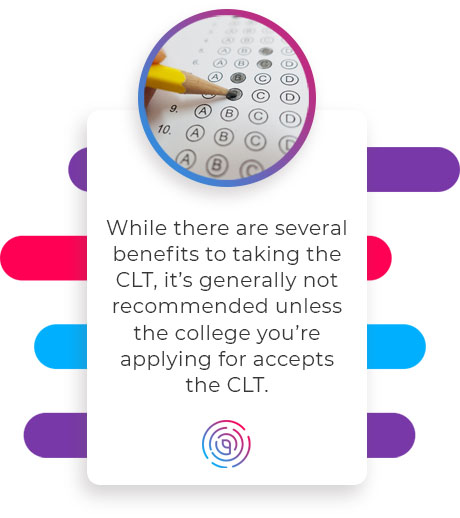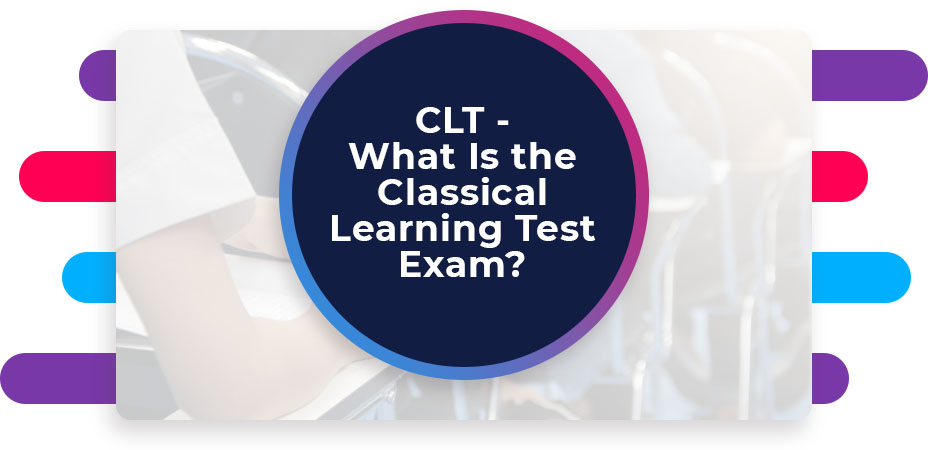Each year, millions of high school students eagerly look forward to their favorite pastime: sitting for a standardized test. Totally kidding. We know that taking the SAT or the ACT (or in some cases, both) is nobody’s idea of a good time. But did you know that there is actually an alternative test to the SAT and ACT?
Enter: the Classical Learning Test (CLT) exam, a relatively new college entrance exam that has been rising in popularity with each passing year. Tens of thousands of students now sit for the CLT in the hopes of gaining entrance into their dream school and earning scholarship dough.
What is the CLT and should you bother taking it? Let’s take a closer look.
About the CLT
The Classical Learning Test is a college entrance exam developed by Classic Learning Initiatives, a company founded in 2015 by former college counselor Jeremy Tate. Designed for high school juniors and seniors, the test consists of 40 questions that cover reading comprehension, grammar, and mathematical and logical reasoning.
The CLT was originally developed to address some of the controversies that have dogged the ACT and the SAT for decades, including accusations of bias and unreliable metrics. One of the standout differences of the new standardized test is that it targets a classical education, a type of education that is commonly taught at liberal arts colleges in the United States.
Going to college? Read our blog – What Is a Liberal Arts College? – to learn more.
The CLT Suite of Assessments
Like the ACT and the SAT, the CLT has its own suite of assessments designed for different grade levels. It includes the flagship test — the CLT — along with two preparatory exams:
- CLT: The CLT was created specifically for juniors and seniors getting ready to apply for college. More than 150 colleges across the U.S. and Canada now accept the CLT for college admissions. (See the most up-to-date list here.)
- CLT10: The CLT10 is designed for freshmen and sophomores. It doesn’t include trigonometry and there are fewer high-difficulty questions. The CLT10 is essentially the equivalent to ACT Aspire and the PSAT.
(Thinking about taking the PSAT? Read our blog – When to Take the PSAT – to learn more.)
- CLT8: The CLT8 is designed for 7th and 8th graders to get them familiar with taking standardized tests. Although the CLT8 features the same format as the CLT10 and CLT, the questions are less difficult.
CLT vs. ACT vs. SAT – What’s the Difference?
How is the CLT different than the ACT or SAT? Here are a few key differences that separate the CLT from the ACT and SAT:
- The CLT Is Online – Unlike the SAT or ACT, the CLT has always been offered as an online test. Not only that, but the test is available on students’ own devices. In other words, no more dealing with an unfamiliar device that could potentially give you trouble on test day.
- It’s Shorter – The CLT is only 120 minutes long, not counting the optional essay that tacks on another 30 minutes. Even with the essay added to the CLT’s length, it’s still shorter than the ACT and SAT, both of which clock in at a minimum of three hours without essays.
- You Get Results Fast – Three words: same day scores. With the CLT, there’s no agonizing for weeks over how you did on the test because you typically get scores back within 24 hours. One caveat, though: The new remote proctoring means that you may not get your scores back for one to two weeks, due to the pandemic. That’s still pretty fast for a standardized test!

Who Should Take the CLT?
The answer mostly depends on which colleges you’re applying for. If you have your heart set on High Point University, Baylor University Honors College, or another liberal arts college that accepts CLT scores, then you may want to consider taking the CLT.
Another reason you might want to take the CLT? Unlike the SAT and ACT, the CLT doesn’t align with the Common Core Standards. If you went to a private school, a charter school, or you were homeschooled, the CLT could potentially be a better measurement of your aptitude and achievements.
How Is the CLT Scored?
The CLT has a scoring range of 0 to 120. Test scores are based on the total number of correct scores. Like the SAT and the ACT, there is no penalty for guessing, so take your best guess on every single question to maximize your chances of getting a good score.
Want to know how your test scores stack up? Check out our blogs – What Is a Good SAT Score? and What Is a Good ACT Score? – to learn more.
Also, be aware that in order for the test to be scored consistently, you must complete the sections in the correct order. Once the allotted time is up, you can’t go back to a section.

Taking the CLT – Yay or Nay?
While there are several benefits to taking the CLT, it’s generally not recommended unless the college you’re applying for accepts the CLT. The number of schools that accept the CLT are currently limited, whereas all universities and colleges that require standardized testing accept the ACT and SAT.
Bottom line? Do your research and don’t be afraid to talk with a school counselor about your standardized testing options.







